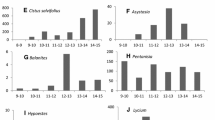Summary
Studies of pollen dispersal in insect-pollinated plants have often documented highly leptokurtic patterns of pollen deposition that can increase the likelihood of long-distance mating. To examine potential causes of highly leptokurtic deposition, we introduce four functions that arise when (1) the duration of pollinator visits to pollen sources is limited, (2) the rate of pollen deposition varies randomly among pollinators and/or among visits, (3) the rate of pollen deposition changes monotonically over time or (4) pollen is carried in layers or compartments on the pollinator's body that differ in deposition rate. Maximum likelihood techniques were used to fit deposition functions to data obtained from honey bees (Apis mellifera L.) visiting mustard plants (Brassica campestris L.) that contained a marker gene. Each of the alternative leptokurtic functions fit the experimental data better than a simple exponential function and the best-fit function predicted a mean pollen dispersal distance more than three times greater than the exponential. We argue that studies of pollen deposition need to test a broader range of deposition models to assess outcrossing distance in plant populations accurately.
Similar content being viewed by others
References
Akaike, H. (1973) Information theory and an extension of the maximum likelihood principle. InInternational Symposium on Information Theory (B.N. Petran and F. Csaki, eds), 2nd edn, pp. 267–81. Akademiai iadi, Budapest, Hungary.
Bateman, A.J. (1947) Contamination of seed crops. III. Relation with isolation distance.Heredity 1, 303–36.
Campbell, D. (1985) Pollen and gene dispersal: the influences of competition for pollination.Evolution 39, 418–31.
Campbell, D.R. and Waser, N.M. (1989) Variation in pollen flow within and among populations ofIpomopsis aggregata.Evolution 43, 1444–55.
Crawford, T.J. (1984) What is a population? InEvolutionary ecology. Twenty-third Symposium of the British Ecological Society (B. Shorrocks, ed.), pp. 135–73. Blackwell, Oxford.
Galen, C. and Plowright, R.C. (1984) The effects of nectar level and flower development on pollen carryover in inflorescences of fireweed (Epilobium angustifolium) (Onagraceae).Can. J. Bot. 63, 488–91.
Galen, C. and Rotenberry, J.T. (1988) Variance in pollen carryover in animal-pollinated plants: implications for mate choice.J. Theor. Biol. 135, 419–29.
Geber, M. (1985) The relationship of plant size to self-pollination inMertensia ciliata.Ecology 66, 762–72.
Kvålseth, T.O. (1985) Cautionary note aboutR 2.Am. Stat. 39, 279–85.
Lertzman, K.P. and Gass, C.L. (1983) Alternative models of pollen transfer. InHandbook of experimental pollination biology (C.E. Jones and R.J. Little, eds), pp. 474–89. Van Nostrand Reinhold, New York.
Levin, D.A. (1984) Inbreeding depression and proximity-dependent crossing success inPhlox drummondii.Evolution 38, 116–27.
Levin, D.A. and Kerster, H.W. (1974) Gene flow in seed plants.Evol. Biol. 7, 139–220.
Levin, D.A. Kerster, H.W. and Niedzlek, M. (1971) Pollinator flight directionality and its effect on pollen flow.Evolution 25, 113–18.
Manasse, R. (1992) Ecological risks of transgenic plants: effects of spatial dispersion on gene flow.Ecol. Appl. 2, 421–38.
Martz, H.F. and Waller, R.A. (1982)Bayesian Reliability Analysis. Wiley, New York.
Morris, W.F. (1993) Predicting the consequences of plant spacing and biased movement for pollen dispersal by honey bees.Ecology 74, 493–500.
Morris, W.F., Price, M.V., Waser, N.M., Thomson, J.D., Thomson, B. and Stratton, D.A. (1994) Systematic increase in pollen carryover and its consequences for geitonogamy in plant populations.Oikos, in press.
Portnoy, S. and Willson, M.F. (1993) Seed dispersal curves: behavior of the tail of the distribution.Evol. Ecol. 7, 25–44.
Price, M. and Waser, N. (1979) Pollen dispersal and optimal outcrossing inDelphinium nelsoni.Nature 277, 294–7.
Price, M.V. and Waser, N.M. (1982) Experimental studies of pollen carryover: hummingbirds andIpomopsis aggregata.Oecologia 54, 353–8.
Robertson, A.W. (1992) The relationship between floral display size, pollen carryover and geitonogamy inMyosotis colensoi (Kirk) Macbride (Boraginaceae).Biol. J. Linn. Soc. 46, 333–49.
Sakamoto, Y., Ishiguro, M. and Kitagawa, G. (1986)Akaike information criterion statistics. D. Reidel, Dordrecht.
Schaal, B.A. (1980) Measurement of gene flow inLupinus texensis.Nature 284, 450–1.
Svensson, L. (1985) An estimate of pollen carryover by ants in a natural population ofScleranthus perennis L. (Caryophyllaceae).Oecologia 66, 373–7.
Thomson, J.D. (1986) Pollen transport and deposition by bumble bees inErythronium: influences of floral nectar and bee grooming.J. Ecol. 74, 329–41.
Thomson, J.D. and Plowright, R.C. (1980) Pollen carryover, nectar rewards, and pollinator behavior with special reference toDiervilla lonicera.Oecologia 46, 68–74.
Thomson, J.D. and Thomson, B.A. (1989) Dispersal ofErythronium grandiflorum pollen by bumblebees: implications for gene flow and reproductive success.Evolution 43, 657–61.
Thomson, J.D., Price, M.V., Waser, N.M. and Stratton, D.A. (1986) Comparative studies of pollen and fluorescent dye transport by bumble bees visitingErythronium grandiflorum.Oecologia 69, 561–6.
Waser, N.M. (1988) Comparative pollen and dye transfer by pollinators ofDelphinium nelsonii.Funct. Ecol. 2, 41–8.
Waser, N.M. and Price, M.V. (1982) A comparison of pollen and fluorescent dye carry-over by natural pollinators ofIpomopsis aggregata (Polemoniaceae).Ecology 63, 1168–72.
Waser, N.M. and Price, M.V. (1983) Optimal and actual outcrossing in plants, and the nature of plant-pollinator interaction. InHandbook of experimental pollination biology (C.E. Jones and R.J. Little, eds), pp. 341–59. Van Nostrand Reinhold, New York.
Waser, N.M. and Price, M.V. (1984) Experimental studies of pollen carryover: effects of floral variability inIpomopsis aggregata.Oecologia 62, 262–8.
Waser, N.M. and Price, M.V. (1989) Optimal outcrossing inIpomopsis aggregata: seed set and offspring fitness.Evolution 43, 1097–109.
Wilkinson, L. (1989)SYSTAT: The System for Statistics. Systat, Inc., Evanston, Il.
Wright, S. (1969)Evolution and the Genetics of Populations. Vol. 2. The Theory of Gene Frequencies. University of Chicago Press, Chicago.
Zwillinger, D. (1989)Handbook of Differential Equations. Academic Press, Boston.
Author information
Authors and Affiliations
Rights and permissions
About this article
Cite this article
Morris, W.F., Mangel, M. & Adler, F.R. Mechanisms of pollen deposition by insect pollinators. Evol Ecol 9, 304–317 (1995). https://doi.org/10.1007/BF01237776
Issue Date:
DOI: https://doi.org/10.1007/BF01237776




